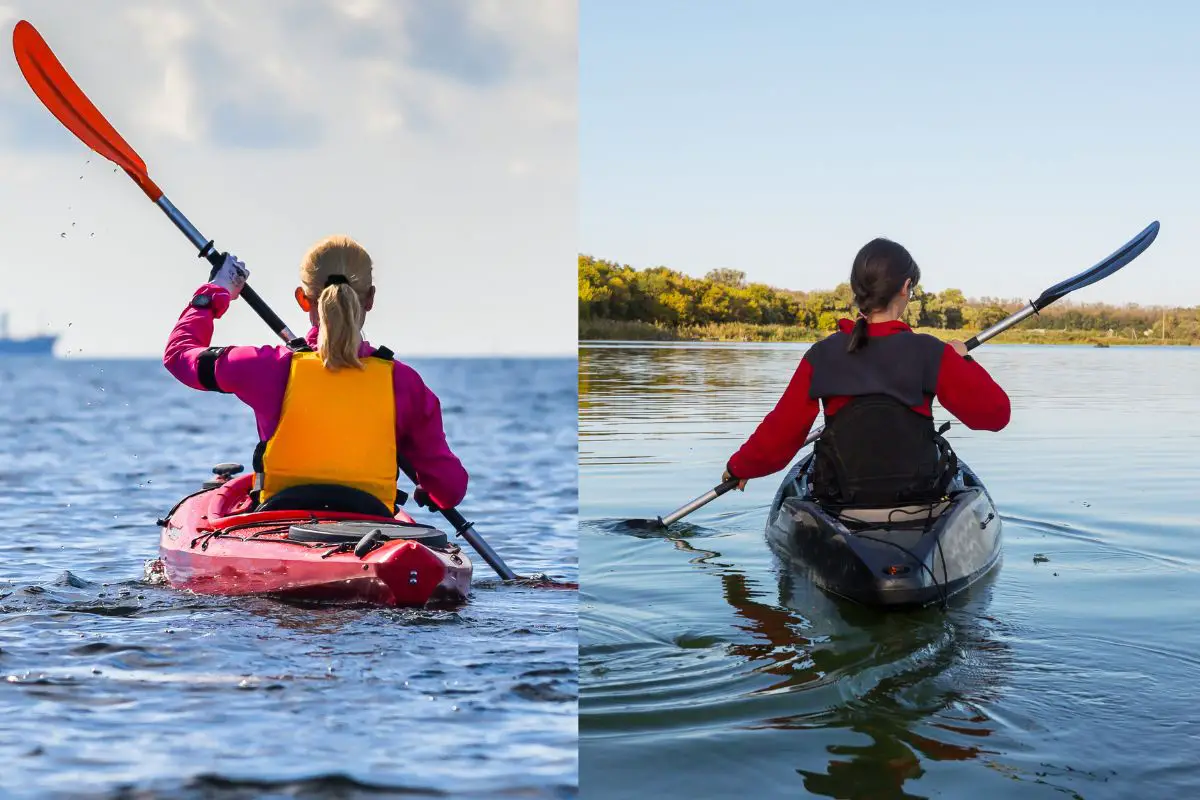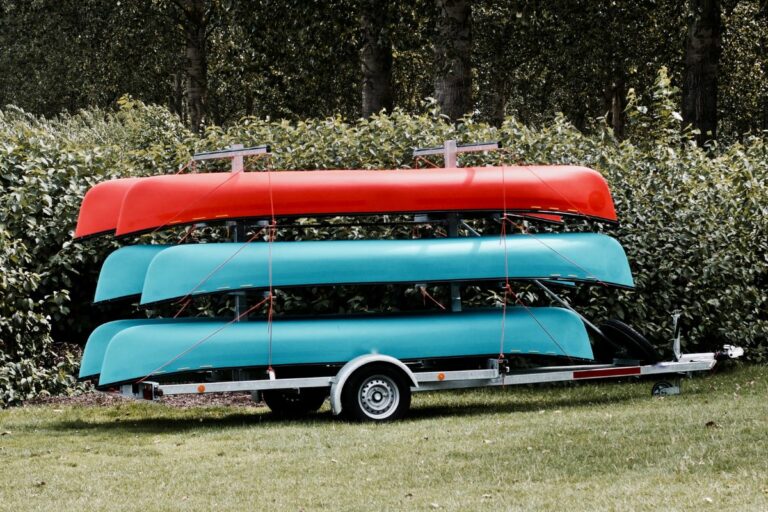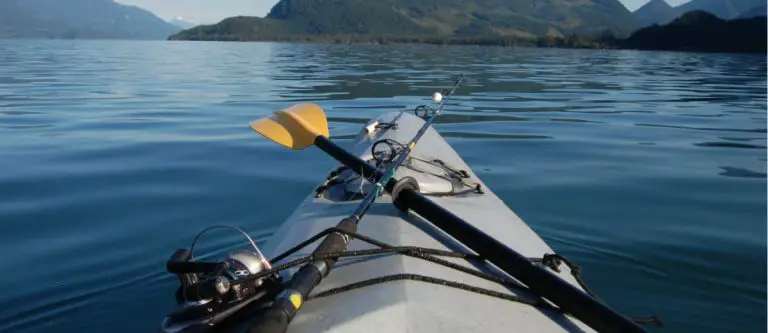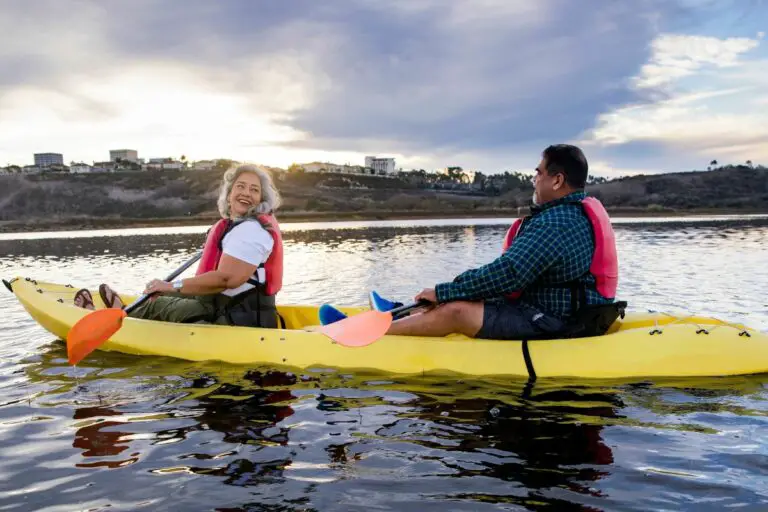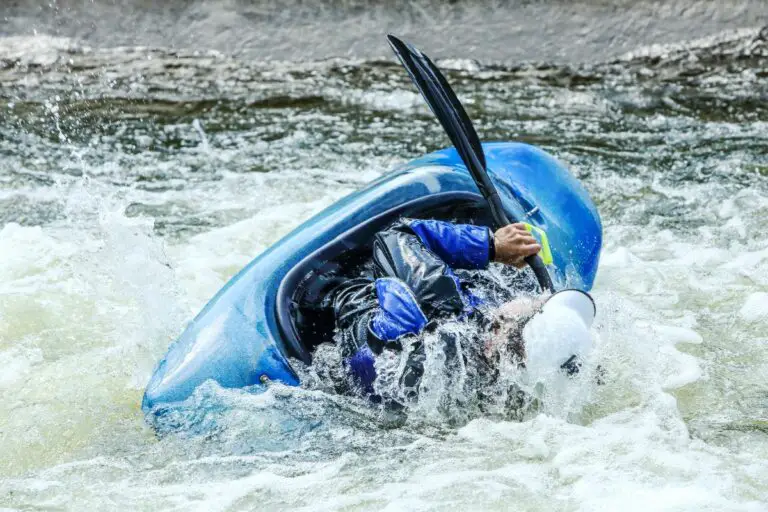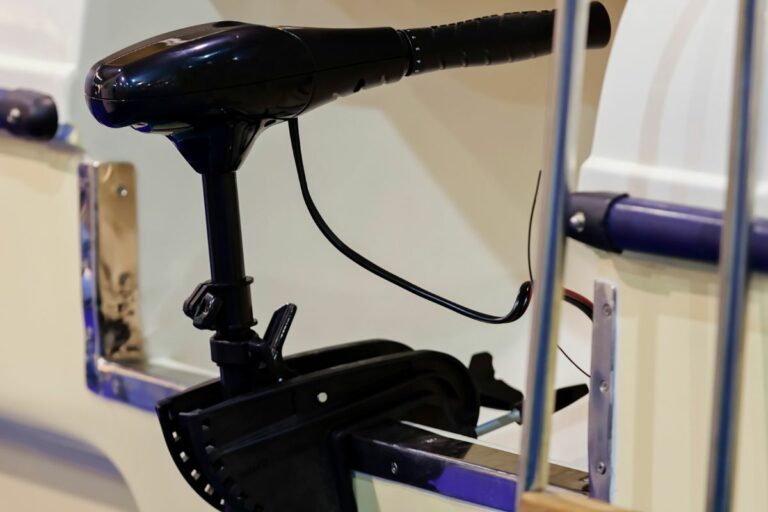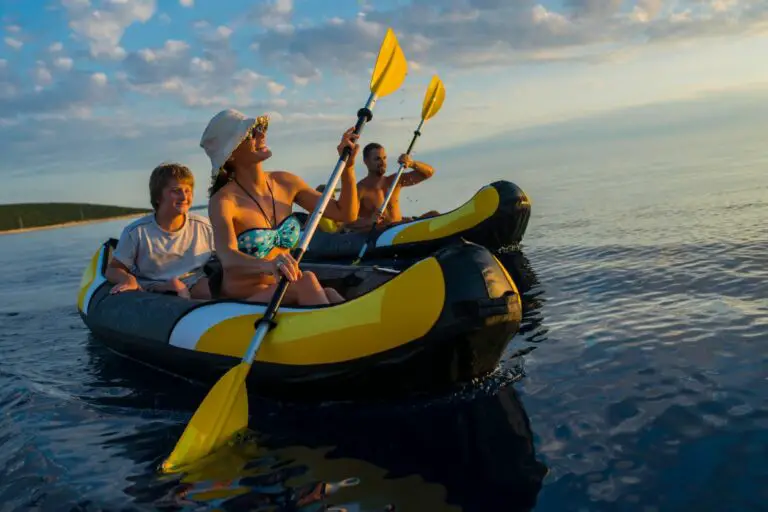Sea Kayaking vs. River Kayaking: 5 Differences You Must Know
Sea kayaking and river kayaking are two distinct types of kayaking that offer unique experiences for outdoor enthusiasts.
While both involve paddling a small watercraft, the environment and conditions in which they are practiced can vary significantly, requiring different skills and equipment.
So, here’s a quick breakdown of the differences between sea kayaking vs. river kayaking:
| Sea Kayaking | River Kayaking | |
|---|---|---|
| Kayak Type | Sea kayaks are longer and narrower, with a sharper bow and stern. | River kayaks are shorter and wider, with a rounder bottom. |
| Environment | Sea kayaking takes place in the open ocean or large bodies of water like bays, lakes, and lagoons. | River kayaking takes place in moving water with a current, typically in narrow channels, rapids, or whitewater. |
| Water Conditions | Sea kayaking often involves dealing with waves, tides, and wind. | River kayaking requires dealing with rapids, eddies, and varying water levels. |
| Required Skill Level | Sea kayaking requires more advanced skills than river kayaking, such as navigation, reading water, and dealing with challenging conditions such as waves and wind. | River kayaking requires specific skills that are more focused on maneuvering in moving water with a current and dealing with changing water levels. |
| Safety Concerns | Sea kayaking involves open water, which can have unpredictable weather and water conditions. | River kayaking involves moving water with obstacles such as rocks and debris. |
Keep reading to learn more about the differences between sea Kayaking and river Kayaking and which one of them is better for you.
Table of Contents
What Is the Difference Between Sea Kayaking and River Kayaking?
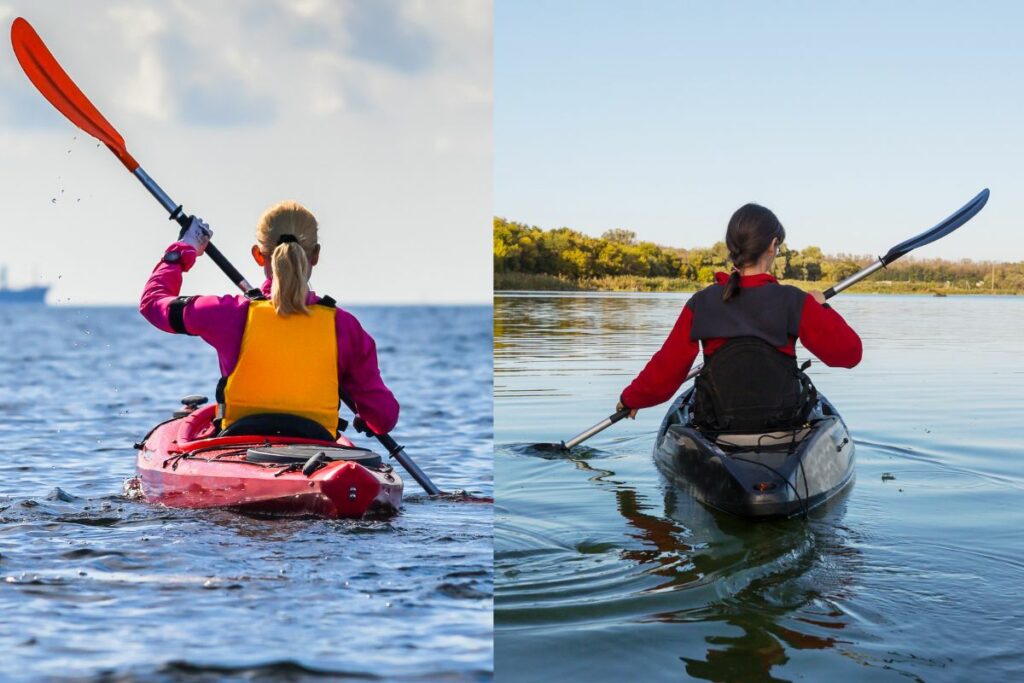
There are various differences between sea kayaking and river kayaking, and by understanding these differences, you can decide which of the two activities best suits your skills, preferences, and comfort level.
So, let’s explore some of the key differences between sea kayaking and river kayaking:
Kayak Type
The kayak type used in sea and river kayaking is quite different.
Sea kayaks are designed for open water, generally longer, narrower, and have a sharper bow and stern. They are built for speed and efficiency, which helps paddlers to cover long distances more easily.
Sea kayaks are also more stable in choppy conditions and have a large storage capacity for carrying gear.
In contrast, river kayaks are shorter and more maneuverable, designed to navigate through rapids and tight spaces. They are typically wider and have a rounder bottom, which makes them more stable in fast-moving water.
River kayaks also have a more pronounced rocker, which is the curve at the bottom of the boat that helps to turn quickly.
If you’re interested in learning more about the difference between other types of kayaks, you can check out my guides on the difference between touring kayaks and sea kayaks and the difference between fishing kayaks and sea kayaks here.
Can You Use A Sea Kayak in the River?
You can use a sea kayak in the river. However, remember that sea kayaks are longer and narrower than river kayaks, making them more challenging to maneuver in rapids and eddies.
Additionally, sea kayaks may not have the same level of durability as river kayaks, so they will be more susceptible to damage from rocks and other obstacles in the river.
Can You Use A Regular Kayak in the Sea?
You can use a regular kayak in the sea, but it may not be the most suitable or safe option.
Using a regular kayak in the sea can be risky, especially in rough water conditions, as they’re designed for calm waters such as lakes, rivers, and streams. It’ll be less stable and can easily tip over in waves or strong currents, leaving you at risk of injury or drowning.
Can You Use An Inflatable Kayak in the Sea?
You can use an inflatable kayak in the sea, but you need to choose the right type of inflatable kayak because not all inflatable kayaks are suitable for use in the sea.
Make sure to choose a kayak that has the necessary features, such as a reinforced bottom and sides, to withstand the rigors of paddling in open water. Additionally, it’s important to check the kayak’s weight capacity and ensure it can support your weight and any gear you plan to bring with you.
Environment
One of the most significant differences between sea kayaking and river kayaking is the environment in which they take place.
Sea kayaking typically takes place on the open ocean or large bodies of water like bays, lakes, and lagoons. In contrast, river kayaking involves navigating through the rapids and currents of rivers and streams.
Water Conditions
The water conditions for sea kayaking and river kayaking vary depending on the environment.
Sea kayaking often involves dealing with waves, tides, and wind, which can create challenging conditions for even experienced kayakers. Meanwhile, river kayaking involves dealing with rapids, eddies, and varying water levels.
Required Skill Level
Sea kayaking and river kayaking require different skill sets and levels of experience due to the differences in environment, water conditions, and equipment.
Sea kayaking typically requires more advanced skills than river kayaking. This is because sea kayakers need to be able to navigate through challenging water conditions, such as waves, wind, and currents.
Sea kayakers must also be able to read the water and understand how different conditions can affect their paddling. In addition, they need to be prepared to deal with potential hazards such as strong offshore winds, heavy surf, and marine life.
River kayaking also requires specific skills, but they are generally more focused on maneuvering in moving water with a current and dealing with changing water levels.
River kayakers need to be able to read the water and anticipate changes in the current to navigate safely. They must also be skilled in eddy turns, ferrying, and bracing techniques to maneuver around obstacles such as rocks and rapids.
However, whatever type of kayaking you are going to do, I still highly recommend spending some time taking kayaking lessons and practicing in a safe environment before heading out in the open water alone.
Safety Concerns
Sea kayaking and river kayaking both involve certain safety concerns that are unique to each activity. Understanding these risks is critical to ensuring the safety of yourself and others while out on the water.
So, let’s take a quick look at the key safety concerns for each activity:
| Sea Kayaking | River Kayaking |
|---|---|
| Sea kayakers need to be aware of weather conditions and how they can change rapidly. Strong winds, rain, and fog can affect visibility and make paddling more difficult. | River kayaking takes place in moving water with a current, which can vary in speed and turbulence. Kayakers must be able to read the water and anticipate changes in the current. |
| Open water can have choppy waves, strong currents, and tides. Sea kayakers must understand these conditions and how to paddle through them safely. | Rivers can have obstacles such as rocks, rapids, and debris. Kayakers must be able to maneuver around these obstacles safely. |
| The water in the ocean can be cold, which can lead to hypothermia if kayakers are not properly dressed or equipped. | Even in warmer months, river water can be cold and lead to hypothermia if kayakers are not properly dressed or equipped. |
| Sea kayakers must have the necessary navigation skills and equipment to stay on course and avoid getting lost. | Strainers are obstacles in the water, such as fallen trees or branches, that can trap kayakers and cause drowning. |
| Sea kayakers may encounter marine life, such as sharks, jellyfish, and whales. Kayakers must take precautions to avoid interactions with these animals. | In shallow water, kayakers can become trapped or pinned by their feet, which can be extremely dangerous. |
You can learn more about the dangers of kayaking in the sea and how to avoid them here.
How to Stay Safe When Kayaking?
Both sea kayaking and river kayaking involve unique safety concerns, so proper safety equipment, skills, and knowledge are essential for both activities to ensure a safe and enjoyable experience on the water.
Here are some tips for staying safe whether you’re sea kayaking or river kayaking:
- Always wear a properly fitting PFD while kayaking, regardless of your skill level or experience.
- Dress appropriately for the water temperature, not the air temperature. In cold water, wear a wetsuit or dry suit to prevent hypothermia. Learn more about kayaking in cold weather here.
- Take lessons or practice proper paddling techniques to avoid fatigue and injury.
- Before kayaking, research the water conditions, including the tides, currents, and weather forecasts. Avoid kayaking in conditions that are beyond your skill level. Learn when not to go kayaking here.
- Bring appropriate safety gear such as a whistle, flares, and a waterproof communication device.
- Learn and practice rescue techniques such as self-rescue and assisted rescues with a partner or group.
- Bring enough water and snacks to stay hydrated and fueled during your kayaking trip.
- Kayak with a partner or group for safety and social support.
- Follow navigation rules, including local boating laws and regulations, and avoid areas with heavy boat traffic.
- Regularly check your kayak and equipment for any damage or wear, including the hull, rudder, and paddle.
When Is the Best Time to Go Sea Kayaking?
Overall, the best time to go sea kayaking is during calm and sunny weather conditions, in warmer water temperatures.
Researching the specific area you plan to kayak to understand the local weather patterns, tides, and currents is important. By planning your trip around these factors, you can ensure a safe and enjoyable sea kayaking experience.
Sea Kayaking vs. River Kayaking: Pros and Cons
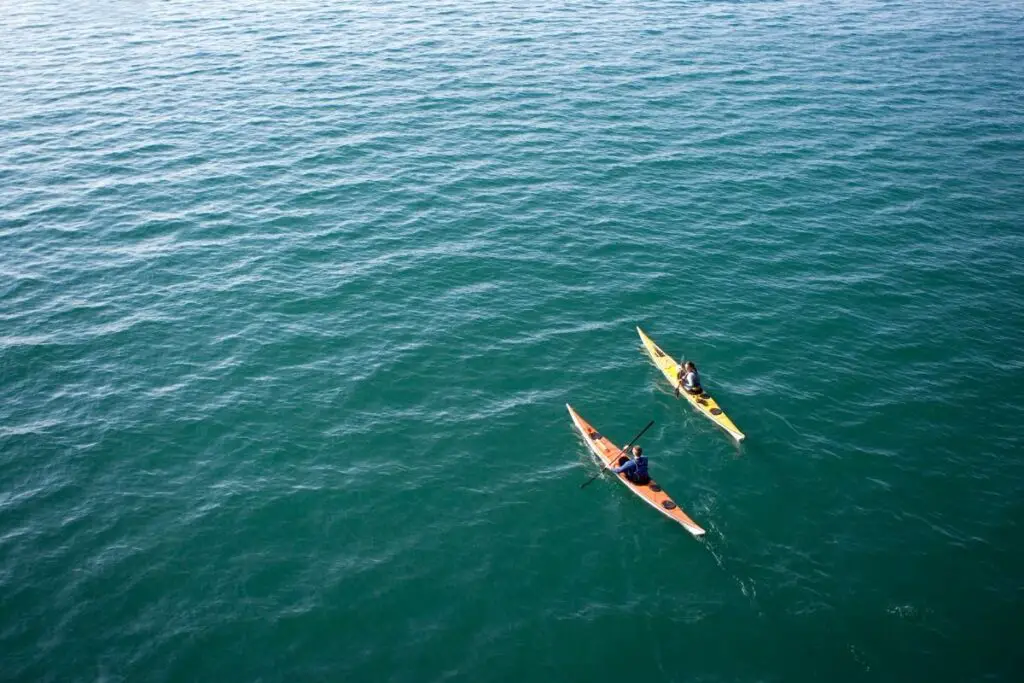
Now that you know the differences between sea kayaking and river kayaking, it’s time to take a look at the pros and cons of each activity to help you decide which one is better for you.
| Sea Kayaking | River Kayaking | |
|---|---|---|
| Pros | Scenic views: Sea kayaking provides access to beautiful coastal scenery, including sea caves, rocky shorelines, and marine wildlife. Adventure: Sea kayaking can be exciting, especially in rough water conditions, which can challenge your skills and endurance. Physical exercise: Paddling a sea kayak can provide a great workout for your upper body, core, and cardiovascular system. Gear: Sea kayaks are designed to carry all necessary gear for longer trips, including camping equipment and food. | Accessible: River kayaking can be enjoyed in various locations, including urban areas and rural settings, making it more accessible to many people. Consistent conditions: River conditions are typically more predictable than the sea, with fewer surprises, and are easier to navigate. Community: River kayaking can offer a sense of community with other paddlers who may share the same interests and experiences. Affordable: River kayaking equipment can be more affordable than sea kayaking gear. |
| Cons | Weather conditions: Weather can be unpredictable in the sea, and strong winds, waves, and currents can make sea kayaking challenging and dangerous. Navigation: Navigation can be difficult in the sea, especially in foggy or cloudy conditions, which can increase the risk of getting lost or disoriented. Cost: Sea kayaks and gear can be expensive compared to river kayaking equipment. | Limited scenery: River kayaking typically provides less scenic views compared to sea kayaking. Water quality: Some rivers can have poor water quality, which can be harmful to health. Gear: River kayaks may not have as much storage space as sea kayaks, limiting the length and scope of trips. |
So, Which Is Better?
There is no definitive answer to whether sea kayaking or river kayaking is better, as both activities offer different experiences and challenges.
If you enjoy scenic views, adventure, and physical challenges, sea kayaking may be a better option for you. On the other hand, if you prefer consistent conditions and accessibility, it’s best to go for river kayaking.
Ultimately, choosing between the two depends on your preferences and circumstances. Regardless of your choice, it’s essential to prioritize safety and respect the natural environment while enjoying these activities.
Kayak your way to Freedom
- On a budget? Check out the best fishing kayaks under $500 here and the best Fishing Kayaks under $1,000 here. Or Check the best Cheap Kayaks here.
- Going fishing? Here are the best Ocean fishing kayaks, and here are the best River Fishing Kayaks.
- You can also find the best Fly Fishing Kayaks here and the best Bass Fishing Boats here.
- A bit experienced? Check out the best modular kayaks here and the best tandem fishing kayaks here.
- Looking for something special? Check out my favorite Ducky kayaks here.
- Navigate your way with these awesome and beginner-friendly Kayak compasses.
- Going Hunting? These Duck hunting kayaks will give you an unfair advantage!
- Have a need for speed? These motorized kayaks will get you moving.
- Protect yourself from the sun with these Kayak shades, and make your kayak more comfortable with these Kayak seats.
- Keep your feet dry and warm with these superb Kayaking shoes.
- Going Kayaking in cold water? Stay warm with these Kayaking gloves.
- Paddle Less, Fish More with the Best Kayak Motors
- Looking to get a trolling motor on your kayak? Check out the best kayak trolling motor mounts here.
If you like this article, please share it or pin it, you can find the share buttons below. We will really appreciate it ❤️

